
────────────────────────────────────────────────────────────────────── ⋆⋅☆⋅⋆ ───────────────────────────────────────────────────────────────────
Early Life
Ethel, an American citizen, married Robert Mackenzie, a Scottish-born man, in 1909. Under the Expatriation Act, she automatically lost her U.S. citizenship upon her marriage, even though she continued to live in the United States. This loss of citizenship had profound implications, as it denied her the right to vote and other civic privileges.
The Legal Battle
After the 19th Amendment granted women the right to vote in 1920, Ethel, a longtime suffragette, tried to register to vote in California but was denied because her marriage to a foreign national had stripped her of U.S. citizenship under the Expatriation Act. She challenged the law in court, arguing it was unconstitutional and discriminatory. Her case, Mackenzie v. Hare, reached the U.S. Supreme Court in 1915, but the Court upheld the law, ruling that the federal government could determine citizenship and that marriage to a foreigner was a valid reason for expatriation.
Raising Awareness and Driving Change
The Expatriation Act and the Supreme Court's decision highlighted the systemic gender discrimination embedded in U.S. laws at the time. Ethel Mackenzie's case brought national attention to the issue, and her activism contributed to the eventual repeal of the Expatriation Act with the passage of the Cable Act of 1922. This new law allowed American women who married foreign nationals to retain their U.S. citizenship, marking a significant step forward for women's rights.
────────────────────────────────────────────────────────────────────── ⋆⋅☆⋅⋆ ───────────────────────────────────────────────────────────────────
Impact for Asian American Women

Ethel, an American citizen, married Robert Mackenzie, a Scottish-born man, in 1909. Under the Expatriation Act, she automatically lost her U.S. citizenship upon her marriage, even though she continued to live in the United States. This loss of citizenship had profound implications, as it denied her the right to vote and other civic privileges.
After the 19th Amendment granted women the right to vote in 1920, Ethel, a longtime suffragette, tried to register to vote in California but was denied because her marriage to a foreign national had stripped her of U.S. citizenship under the Expatriation Act. She challenged the law in court, arguing it was unconstitutional and discriminatory. Her case, Mackenzie v. Hare, reached the U.S. Supreme Court in 1915, but the Court upheld the law, ruling that the federal government could determine citizenship and that marriage to a foreigner was a valid reason for expatriation.
Raising Awareness and Driving Change
The Expatriation Act and the Supreme Court's decision highlighted the systemic gender discrimination embedded in U.S. laws at the time. Ethel Mackenzie's case brought national attention to the issue, and her activism contributed to the eventual repeal of the Expatriation Act with the passage of the Cable Act of 1922. This new law allowed American women who married foreign nationals to retain their U.S. citizenship, marking a significant step forward for women's rights.
────────────────────────────────────────────────────────────────────── ⋆⋅☆⋅⋆ ───────────────────────────────────────────────────────────────────
Impact for Asian American Women

